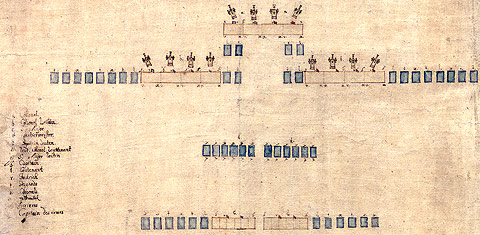| Swedish Brigade |
Prime power in the infantry had shifted from pike to shot more than thirty years prior to this battle. First, the musket due its penetrating power supplanted the weaker arquebus and caliver. Then, battlefield tactics sought to make the most effective use of shot – effective as in the most bullets fired into the enemy in the shortest span of time. The Dutch set an important benchmark with the introduction of coordinated files of musketeers firing and countermarching. As part of their tercio formation, Tilly and his command made successful use of that method.
 |
|
The only known diagram of the Swedish Brigade drawn during the lifetime of King Gustavus Adolphus. This shows 12 cannons whereas other sources have the total as nine. Provided by Daniel Staberg, who holds the rights to reproduce this. |
King Gustavus Adolphus took bullet-delivery efficiency up another great step with the salvé. To present the salvé – plus enhance infantry response to changing battlefield conditions – the king and his officers developed the Swedish Brigade (consisting of three or four battalions). When moving about the field, the Brigade looked from above like what may roughly be described as a flattened triangle. A division of pike was in front to receive and repel cavalry, with more behind them. The Brigade presented a broad and dynamic front that could quickly change its shape to give its salvé. For combat, this configuration allowed musketeers to form a six-deep line to be the entire front of their unit, with five-deep pike behind in support, then more musketeers in reserve - watch the animation below. It could also turn adeptly or shift to one side or another. Last, a brigade could also have support from a small contingent of cavalry attached to it. Contrast to the bulky tercio of the Imperial-Leaguists.
How the Swedish brigade was used in this battle:
"First (saith he), giving fire unto three little Field-pieces that I had before me, I suffered not my muskettiers to give their volleyes till I came within Pistollshot of the enemy, at which time I gave order to the first rancks to discharge at once, and after them the other three: which done we fell pell mell into their ranckes, knocking them downe with the stocke of the Musket and our swords." - Lt. Colonel Muschamp
pg. 18: Pike and Shot Tactics, 1590-1660, by Keith Roberts, Osprey Publ., 2010
The Swedish Brigade was not the perfect solution, though. To keep all its soldiers coordinated, it required more officers and sergeants than the tercio or any other infantry formation at the time. These officers and sergeants needed more training than the average, too. In addition, the Swedes discovered the formation was not as effective on the offense as it was on the defense. In the months following the death of the king in 1632, the Swedes ceased to use their complex Brigade in favor of simpler line formations, which still gave the opportunity to confront an enemy with the dreaded salvé.